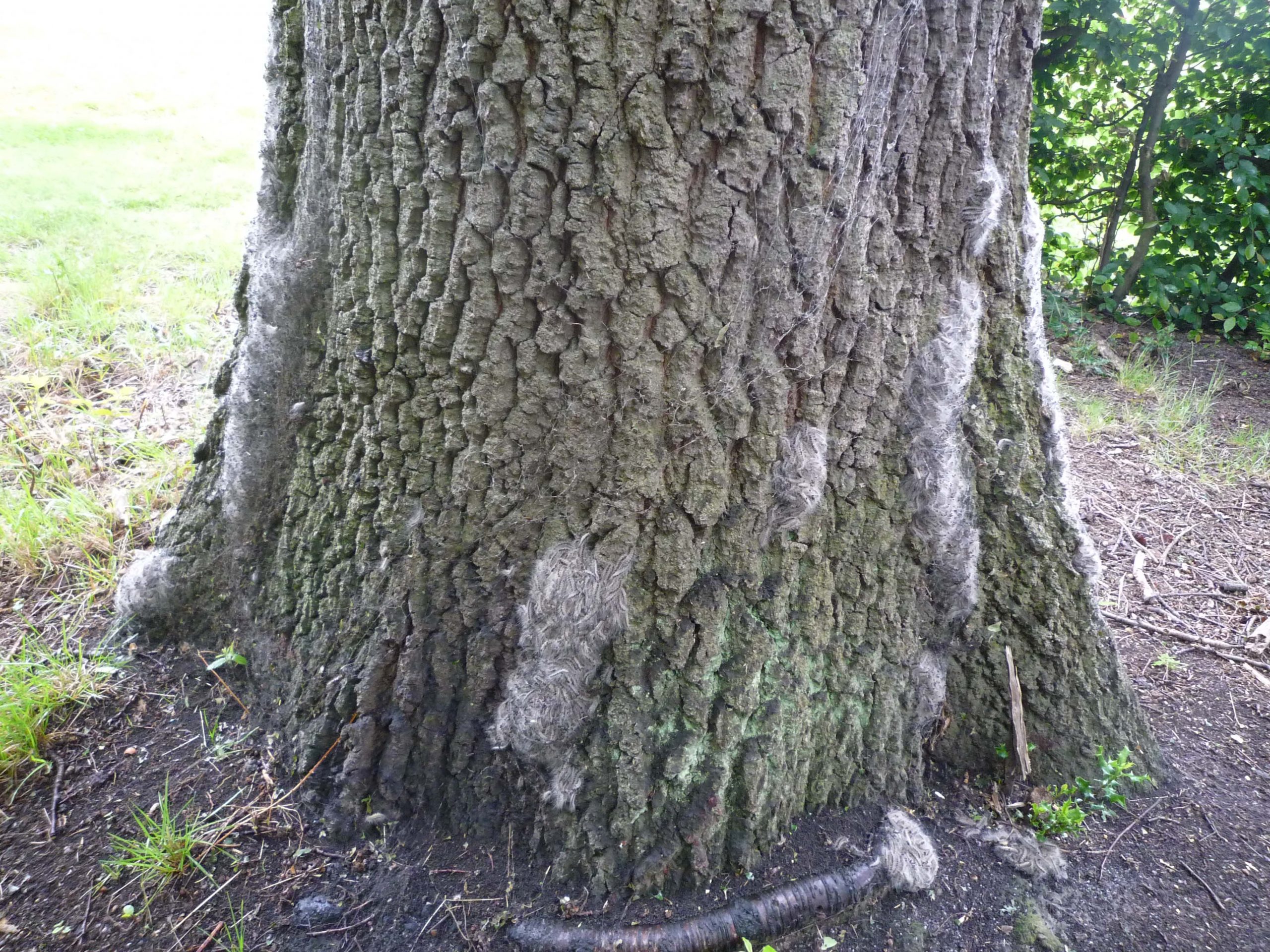The first thing to consider when planning to manually remove oak processionary moth (OPM) nests and caterpillars (larvae) is personal protection from contact with the caterpillars’ irritating hairs.
It is not only the caterpillars which pose a risk: OPM nests (pictured below) also contain thousands of hairs shed by the caterpillars. These continue to pose a health hazard, either through direct contact with the nests, or through the release of the hairs as the nests break up.

The hairs are persistent, remaining a hazard for a year or more until they decay, so it is essential that operators wear appropriate protective equipment. Full body protection, including full head, face and neck cover, and respiration (breathing) equipment, is necessary. The minimum Personal Protective Equipment (PPE) requirements for working with OPM caterpillars or nests are set out in Section 8 – Occupational Health.
Destroying the nests during the daytime in May and June will kill the larvae in the nests. However, there is no guarantee during this period that all the caterpillars living on the tree will be in the nests – while most might be in the nests during the daytime, some might still be feeding on the leaves, and will therefore not be destroyed by nest removal.
Removing and destroying nests between late June and early August is therefore likely to be more effective, because by this time all of the larvae will have settled into the nest as pupae, and none of them will be out on the foliage. It is therefore unlikely that any of the pupae will survive treatment to breed another generation.
Removing the nests of OPM once they have flown (usually in August) will not control them. You may wish to consider this if you think the toxic hairs still present in the nests pose a health threat to people and/or animals. However, in all other cases, the recommendation is to leave nests; they can potentially host parasitoids of OPM which can help to control pest numbers.
The most efficient and safe method for removing nests, and dead and living caterpillars and their hairs, is to use commercial vacuum cleaning equipment. Cleaners need to be capable of working to a high-efficiency particulate air filter (HEPA) specification. Filter specifications of H14 and H13 should meet OPM requirements, and suitable equipment should be available from most good equipment hire companies.
In most cases, where small numbers of trees are involved, hiring a professional to carry out the work is likely to be the most cost-effective option. However, if you own or manage many trees, you might find it cost effective to buy or hire the appropriate equipment, including personal protective equipment (PPE), and attending, or sending your staff to, relevant training courses.
We also recommend that you take out insurance for the work.
This is a specialised operation, and a number of limiting factors need to be carefully assessed before any work is carried out. These can include site access and ground conditions for using mobile platforms (‘cherry pickers’), which can readily be hired, and any street access required will need to be agreed with the local council.
See also the Standard Operating Procedure for removing OPM material by professional vacuum cleaner.
Nests can also be removed by hand. It is recommended that, wherever practicable, each nest is removed intact by first covering it with a plastic bag and then carefully pulling it off, retaining it in the bag. The bag should be sealed immediately and placed in a second bag. Spraying the nest with hair lacquer before bagging it can help to prevent hairs being dislodged.
Nest removal is often best left to professionals. Details of businesses able to carry out this work can be obtained from:
Nest removal, whether by vacuum equipment or by hand, cannot completely eradicate OPM, but it has the advantage of having little effect on other, harmless insects. It can also be more acceptable than chemical control from an environmental point of view, and for this reason it might be the only option permitted in SSSIs.
Further advice on training and certification for the operations described in this manual, especially chemical spraying, climbing, working from cherry pickers and the use of PPE, is available from a number of sources, including colleges and City and Guilds Land-Based Services.
OPM nest material is classified as hazardous waste, but no further action is required if it is incinerated on site. Check with the local council whether incineration is permitted.
However, its transport and destruction are regulated if it is to be moved off site. A consignment note must be completed to accompany the waste when it is moved from any premises, including privately owned land, and records must be kept.
Professional pest control and arboricultural companies must be familiar with the regulations and ensure that their requirements are met.
If, however, you have carried out the work yourself and are not planning to use a waste management company which is registered to handle and dispose of hazardous waste, you should consult the Environment Agency on: